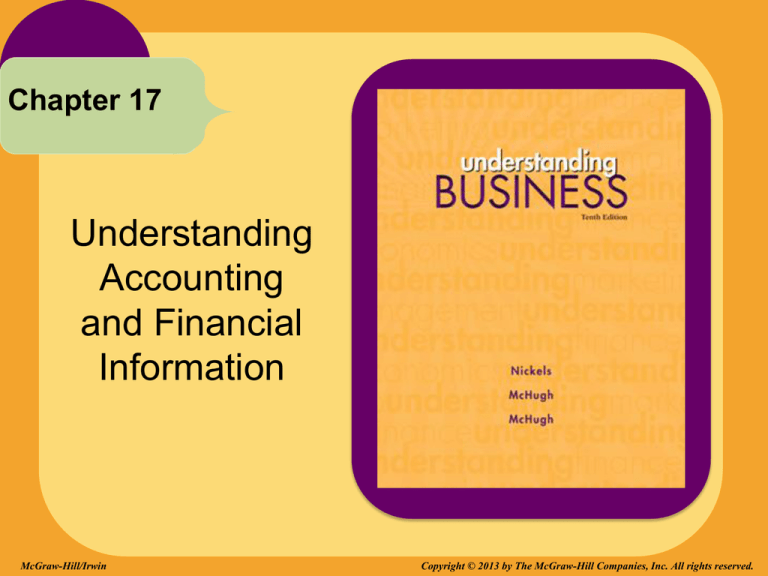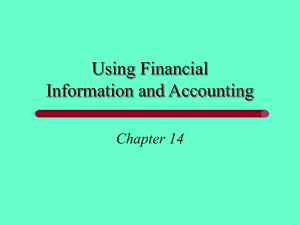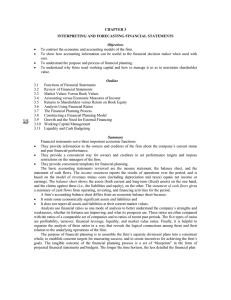
Chapter 17
Understanding
Accounting
and Financial
Information
McGraw-Hill/Irwin
Copyright © 2013 by The McGraw-Hill Companies, Inc. All rights reserved.
Chapter
Seventeen
LEARNING GOALS
1. Demonstrate the role that accounting and financial
information play for a business and for its
stakeholders.
2. Identify the different disciplines within the
accounting profession.
3. List the steps in the accounting cycle, distinguish
between accounting and bookkeeping, and explain
how computers are used in accounting.
4. Explain how the major financial statements differ.
5. Demonstrate the application of ratio analysis in
reporting financial information.
17-2
What is
Accounting?
WHAT’S ACCOUNTING?
LG1
• Accounting -- Recording, classifying, summarizing
and interpreting of financial events and transactions
in an organization to provide interested parties
needed financial information.
• Outside parties - like employees, owners,
creditors, unions, investors and the government make use of a firm’s accounting information.
17-3
What is
Accounting?
The ACCOUNTING SYSTEM
LG1
17-4
The
Accounting
Cycle
The ACCOUNTING CYCLE
LG3
• Accounting Cycle -- A six-step procedure that
results in the preparation and analysis of the major
financial statements.
17-5
The
Fundamental
Accounting
Equation
LG4
The FUNDAMENTAL
ACCOUNTING EQUATION
• Fundamental Accounting Equation -- The basis
for the balance sheet.
• The equation must always be balanced and
includes the formula:
Assets = Liabilities + Owners Equity
17-6
Financial
Accounting
LG2
HOW to READ
an ANNUAL REPORT
• Financial Statement -- A summary of all the
financial transactions that have occurred over
a particular period.
• Key things to watch for and read:
- Management’s discussion and analysis of
operations
- Balance sheet
- Income statement
- Statement of cash flows
- Auditor’s opinion
17-7
The Balance
Sheet
The BALANCE SHEET
LG3
• Balance Sheet -- The financial statement that
reports a firm’s financial condition at a specific
time.
17-8
Classifying
Assets
ASSETS
LG4
• Assets -- Economic resources owned by a firm.
Items can be tangible or intangible.
• Liquidity -- Ease with which assets can be
converted into cash.
• Current Assets -- Items that can or will be
converted to cash within one year.
• Fixed Assets -- Long-term assets that are relatively
permanent such as land, buildings, or equipment.
• Intangible Assets -- Long-term assets that have no
physical form but do have value such as patents,
trademarks, and goodwill.
17-9
Liabilities and
Owners’
Equity
Accounts
CLASSIFYING LIABILITIES
LG4
• Liabilities -- What the business owes to others - its
debts.
• Accounts Payable -- Current liabilities a firm owes
for merchandise or services purchased on credit.
• Notes Payable -- Short or long-term liabilities a
business promises to pay by a certain date.
• Bonds Payable -- Long-term liabilities that the firm
must pay back.
17-10
Liabilities and
Owners’
Equity
Accounts
OWNERS’ EQUITY ACCOUNTS
LG4
• Owners’ Equity -- The
amount of the business that
belongs to the owners minus
any liabilities of the owners.
• Retained Earnings -Accumulated earnings from
the firm’s profitable
operations that are reinvested
in the business.
17-11
The Income
Statement
The INCOME STATEMENT
LG4
• Income Statement -- The financial statement that
shows a firm’s bottom line - that is, its profit after
costs, expenses, and taxes.
• Net Income/Net Loss -- The revenue left over
after costs and expenses.
17-12
Cost of Goods
Sold
LG4
ACCOUNTS of the INCOME
STATEMENT
• Revenue is the monetary value a firm received for
goods sold, services rendered or other payments.
• Cost of Goods Sold (or Manufactured) -- Measures
the cost of merchandise the firm sells or the cost of raw
materials and supplies it used in producing items for
resale.
• Gross Profit (or Gross Margin) -- How much a firm
earned by buying (or making) and selling merchandise.
• Operating Expenses – Cost involved in operating a
business, such as rent, salaries and supplies.
• Depreciation -- The systematic write-off of the cost of a
tangible asset over its estimated useful life.
17-13
The
Statement of
Cash Flows
The STATEMENT of CASH FLOWS
LG4
• Statement of Cash Flows -- Reports cash
receipts and cash disbursements related to the three
major activities of a firm:
1. Operations
2. Investments
3. Financing
•
•
Cash Flow -- The difference between cash coming in and cash
going out of a business.
Managing cash flow is a key consideration of a business and can
be particularly challenging for small and seasonal businesses.
17-14
Managerial
Accounting
LG2
USERS of ACCOUNTING
INFORMATION
Users
Type of Report
Government tax authority
Tax reports
Government regulatory
agencies
Required reports
People interested in the
organization’s income
Financial statements found in
annual reports
Managers of the firm
Financial statements and
internally distributed financial
reports
17-15
Financial
Accounting
LG2
PUBLIC vs. PRIVATE
ACCOUNTANTS
• Private Accountants -- Work in a single firm,
government agency, or nonprofit organization.
• Public Accountants -- Provide accounting
services to individuals or businesses.
• Certified Public Accountants (CPAs) -Accountants who have passed a series of
examinations established by the American Institute of
Certified Public Accountants (AICPA) and met a
states requirements for education and experience.
17-16
Auditing
AUDITING CHECKS ACCURACY
LG2
• Auditing -- Reviewing and evaluating the
information used to prepare a company’s financial
statements.
• Independent Audit -- An evaluation and unbiased
opinion about the accuracy of a company’s financial
statements.
• Certified Internal Auditors (CIAs) -- Accountants
who have a bachelor’s degree and two years of
experience in internal auditing and pass an exam
administered by the Institute of Internal Auditors.
17-17
Managerial
Accounting
MANAGERIAL ACCOUNTING
LG2
• Managerial Accounting -- Provides information
and analysis to managers inside the organization to
assist them in decision making.
• Managerial accounting is involved with:
- Costs of production
- Costs of marketing
- Preparation and control of budgets
- Minimizing tax liabilities
17-18
Financial
Accounting
FINANCIAL ACCOUNTING
LG2
• Financial Accounting -- Financial information and
analyses are generated for people primarily outside
the organization. Outside users are interested in
these questions:
- Is the organization profitable?
- Is it able to pay its bills?
- How much debt does it owe?
• Annual Report -- A yearly statement of the financial
condition, progress, and expectations of the firm.
17-19
Tax Accounting
and Not-for-Profit
Accounting
SPECIALIZED ACCOUNTING
LG2
• Tax Accountants -- Accountants trained in tax law
and are responsible for preparing tax returns or
developing tax strategies.
• Government and Not-forProfit Accounting -Support for organizations
whose purpose is not
generating a profit, but
serving others according to a
duly approved budget.
17-20
The
Accounting
Cycle
BOOKKEEPER’S ROLE
LG3
• Bookkeeping -- The recording of business
transactions. Bookkeepers divide a firm’s
transactions into meaningful categories and post
them into a record book or computer program called
a journal.
• Double-Entry Bookkeeping -- Bookkeepers
record all transactions in two places so they can
check one list of transactions against the other for
accuracy.
17-21
The
Accounting
Cycle
BOOKKEEPER’S TOOLS
LG3
• Ledger -- A specialized
accounting book or
program where all
information is in one
place.
• Trial Balance -- A
summary of all the
information in the account
ledgers.
17-22
Accounting
Technology
TECHNOLOGY and ACCOUNTING
LG3
• Computerized
accounting programs
post information
instantly and from
remote locations.
• Intuit’s QuickBooks
and Sage’s Peachtree
address the specific
needs of small
businesses.
17-23
Analyzing
Financial
Performance
Using Ratios
USING FINANCIAL RATIOS
LG5
• Ratio Analysis -- The assessment of a firm’s
financial condition using calculations and financial
ratios developed from the firm’s financial statements.
• Key ratios include:
- Liquidity ratios
- Leverage ratios
- Performance ratios
- Activity ratios
17-24
Activity Ratio
ACTIVITY RATIOS
LG5
• Activity ratios measure how effectively
management is turning over inventory.
• Key ratios include:
- Inventory turnover ratio
• This information is
found on the firm’s
balance sheet and
income statement.
17-25
The Income
Statement
The INCOME STATEMENT
LG4
• The formula for the income statement:
Revenue
-Cost of Goods Sold
= Gross Profit
-Operating Expenses
= Net Income before Taxes
-Taxes
= Net Income or Net Loss
17-26
Liquidity
Ratios
LG5
COMMONLY USED
LIQUIDITY RATIOS
• Liquidity ratios measure a firm’s ability to turn
assets into cash to pay its short-term debts.
• Two key ratios are:
- Current ratio
- Acid-test ratio
• This information is found on the firm’s balance
sheet.
17-27
Leverage
(Debt) Ratios
LEVERAGE RATIOS
LG5
• Leverage ratios measure the degree to which a
firm relies on borrowed funds in its operations.
• Key ratios include:
- Debt to Owner’s Equity Ratio
• This information is found on the firm’s balance
sheet.
17-28
Profitability
(Performance)
Ratio
PROFITABILITY RATIOS
LG5
• Profitability ratios measure how effectively a
firm’s managers are using the firm’s various
resources to achieve profits.
• Key ratios include:
- Basic earnings per share
- Return on sales
- Return on equity
• This information is found on the firm’s balance
sheet and income statement.
17-29
BARKING UP the
WRONG FINANCIAL STATEMENT
(Making Ethical Decisions)
• You’re the only accountant employed by a small,
struggling dog food company.
• The company requests a bank loan to keep
operations going and your boss suggests you
record some revenue early.
• This is against accounting principles, but you
know if you don’t get the loan, you may lose your
job. What do you do?
17-30




